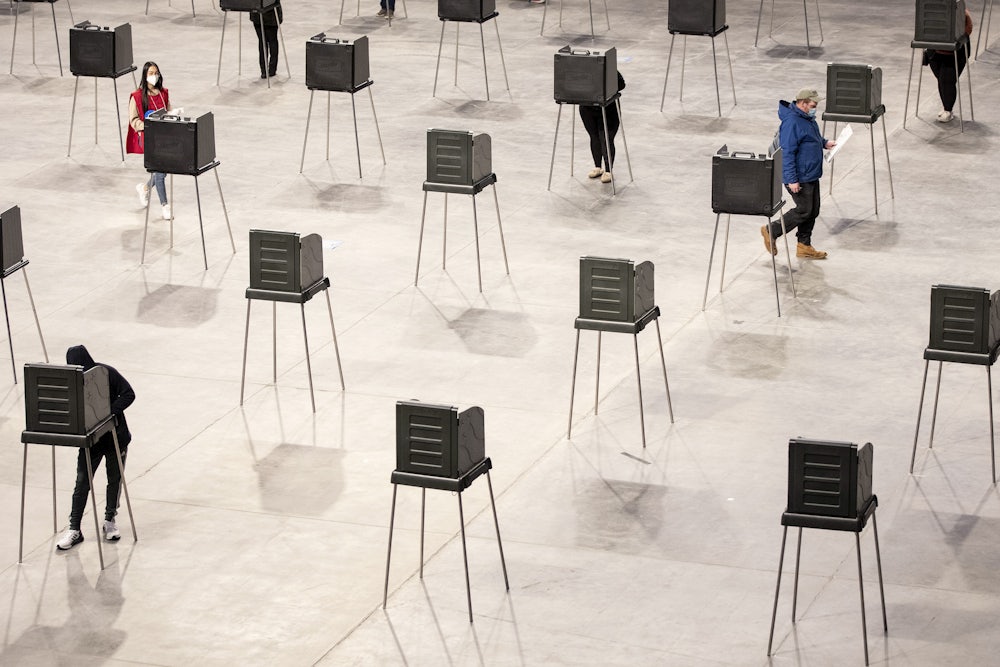Voters don’t care enough about climate, according to conventional wisdom. The best way to address climate change is for Democrats to win elections by talking about other subjects, consultants say. The problem with this political advice is that Democratic politicians, acting on the insight that voters don’t care, get into office and then don’t set a high priority on climate policy—because they want to be reelected.
Put this way, it sounds like we have an almost unsolvable problem on our hands, one that could lead us to believe that representative democracy was incompatible with human survival. Conversations with liberals and progressives these days, especially those engaged in climate issues, are unfailingly gloomy. The right seems to be on a winning streak; relatedly, we’re all doomed. But what if there was a way out of this existential cul-de-sac?
The data nerds and activists behind the Environmental Voter Project, or EVP, think there is. They’ve got extensive research and proven results to support this crazy bit of optimism, and they’re using it to try to sway the midterms, a looming political event that most liberals are hailing with unqualified despair.
“The polls are right,” acknowledges EVP’s Nathaniel Stinnett, an ebullient fellow imbued with the can-do spirit that is generally lacking among progressives right now, “that there are not enough climate-first voters to scare politicians. But boy, is it important to look at who they are polling.” For obvious reasons, political consultants poll consistent voters, and far too few of those list climate as their top priority, Stinnett says.
The big surprise of EVP’s research is that far more nonvoters list climate as their top priority. And what that means, Stinnett says, is that turning nonvoting environmentalists (and “drop off” voters, those who have voted in presidential years but not otherwise) into voters could swing elections.
This may sound like counterintuitive stuff, but others I talked to said it made sense. “There’s no reason to think this finding is off base,” said Trisha Shrum, a University of Vermont behavioral economist who has been studying the drivers of environmentally conscious behavior and is familiar with EVP’s work. Before EVP, she told me, there wasn’t much research on the connections between environmentalism and voting.
While Democrats mainly focus on turning out existing voters (who, while they may be environmentalist, are less likely to put that issue first), the climate movement has been focusing on persuasion. That’s important too, Stinnett says. But in this polarized time, “it’s increasingly hard to change people’s minds. Lots of environmentalists don’t need their minds changed. They need a behavioral change.” These people don’t need to be told to care about the environment. They need to be organized into voting.
How is this done? EVP’s data nerds survey nonvoters and infrequent voters, identifying those who list the environment as their top priority. They also use these people to build predictive models that can identify other nonvoting environmentalists. Volunteers then work to reach every one of these people, many times, to turn them out to vote in local, state, and national elections. They’ve succeeded in getting environmentalists—nonvoters or infrequent voters—to the polls all over the country, from local to congressional elections. This year, EVP argues that “drop off” environmental voters alone could easily swing the midterms in Arizona, North Carolina, Nevada, and New Hampshire; the number of drop-off voters in each of those states far surpasses the margins of victory in the 2018 midterms and, in Pennsylvania, in the 2020 presidential race.
It’s hard to gauge whether EVP is being overly optimistic about environmentalists’ abilities to sway elections. EVP’s reports are full of words like “could,” “as much as,” and “estimated.” It’s hard to measure the impact of voter-turnout organizing like EVP’s precisely or to predict how helpful it will be; we know for sure that it works, but the numbers can never be exact. The people working in EVP are using social science, but they’re activists, and activists’ conception of what is possible is always going to be a step ahead of what’s likely. That’s not necessarily a bad thing, of course—activism can also turn the possible into the likely.
Given the stereotypes of environmentalists as, well, people like me—relatively privileged, white, middle-aged ladies who are civically engaged, more worried about the results of the next election than about paying rent, carrying our reusable bags to the food co-op—the news that so many are not voting will surprise many readers. What is their deal?
The nonvoting environmentalists, according to EVP’s data, are nothing like the environmentalist stereotype: They tend to be young, low-income, or people of color. All those groups vote less than other demographics. And, Stinnett points out, all these groups are targets of right-wing voter suppression; in fact, they are the only groups whose votes are suppressed. But, says Stinnett, the structural barriers and voter suppression these groups face can’t explain everything: People who rank the environment as their top issue are even less likely to vote than others in their demographic.
It’s hard to know why people don’t vote, since, like sex, it’s one of those subjects that people lie about, but Stinnett has a guess. For decades, he says, the environmental movement has been “completely apolitical. Ride your bike. Change your eating habits.” Shrum agrees, saying that until the EVP, “voting wasn’t much of a focus for environmentalists. It wasn’t even something you’d see on short lists for ‘How to Do Your Part to Save the Planet.’”
The National Rifle Association, Stinnett notes, would never depoliticize its members like this; if all these years they’d been telling people to focus on their personal gun ownership rather than on legislation or elections, we’d be living in a different country. The NRA has far fewer adherents than the climate movement but never misses an opportunity to urge them to participate in politics.
Then there’s the action-dampening effect of mainstream environmental discourse: The fossil fuel industry has pushed the narrative that the climate crisis is a matter of individual guilt. Because progressives are susceptible to a guilt trip, and our culture is an individualistic one, its propaganda has affected even many environmentalists, to the point that many of us are more serious about our reusable bags than we are about our vote. “Don’t look at that coal-fired plant,” is how Stinnett paraphrases the fossil fuel industry’s (often successful) message. “It’s your fault for throwing out that plastic spoon.”
People who don’t vote often claim they don’t know enough about politics, but Stinnett says most of these “missing” environmentalist voters do already know which candidates are better for the environment. Accordingly, the EVP does not tell voters whom to vote for. Instead, along with an increasing number of groups committed to voter turnout, the organization uses social pressure to encourage voting, because, Stinnett says, “trying to rationally convince someone to do something rarely works.” Instead, the group might remind them that last May they said they would vote in this election—knowing people like to keep their word—or note how many of their neighbors vote in local elections. EVP also reminds people that “whether you vote is a matter of public record.” That sounds a bit creepy—and I can say from experience writing postcards for groups like this in 2020 that everyone resists using it—but research shows that it works: We all want our fellow humans to think well of us. These turnout strategies are well grounded in behavioral science and used by many other groups, but EVP’s focus on environmental voters is novel.
There’s one other reason environmentalists might sit out elections—a much tougher one for activists to tackle. “People feel it’s not going to make a difference,” Renee Lerzman, a psychologist and climate strategist, told me. That’s consistent with other patterns in environmental behavior: Whether people engage in a specific environmental action, Shrum said, depends heavily on whether they think it is going to be effective.
In this sense, Joe Biden’s recent enthusiasm for drilling, after pledging during his campaign to fight climate change aggressively, could do more damage to the climate than the mere physical consequences of the drilling itself—it could discourage environmental voters. “If we find that our energy and efforts are not impactful,” Lerzman said, “we will redirect. People are disenfranchised, disengaged, resigned, frustrated, disenchanted, and checked out.” Disengaging and checking out, she added, are “well-known strategies that we as humans use to manage our investment in issues that matter to us.” After all, the disappointments can be painful.
The people who worry that voting won’t result in better climate policy have a valid concern. But it’s also a bit of a self-fulfilling prophecy: Stinnett says one reason that voting doesn’t seem to make a difference is that politicians know that not enough environmentalists are voting. Biden talked big about climate in New Hampshire when Bernie Sanders was beating him in the primary, in order to win votes. Now he’s drilling because polls show Americans are worried about high gas prices and inflation. But if environmentalists were voting, particularly in midterms, Stinnett argues, the calculations of politicians like Biden would look different.
The EVP’s approach is not going to save the world all by itself. Countering the despair many people feel will take empathy, Lerzman told me—something she feels is lacking in climate discussions. We will need to listen more and pitch less. And there is more to changing the system than voting and winning elections. A million more voters in the system won’t help, after all, if both parties are owned by Big Oil. We also need to build stronger working people’s institutions like unions, tenants’ associations, membership-based socialist and environmental groups to counter all those billionaire dollars from Koch and Exxon.
But EVP’s idea is at once hopeful and rigorously well supported—a rare combination of qualities these days. It’s also incredibly easy to plug into as a volunteer. Almost any activity, it’s true, would beat the despair of doomscrolling ecosystem collapse and racist violence. But there’s a particular relief in an alternative that could help us crawl out of this wreckage.










